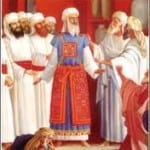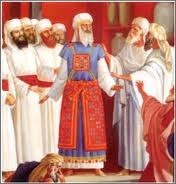 The word for clothing in Hebrew is “Beged” and its root seems to be connected to the Hebrew word for betrayal and deception, BAGAD, for after all the role of clothing is to hide and conceal. We are living in a time and in a world where falsehood and evil is dressed up in pretty clothing and flourishes unchallenged. The commonly heard phrase is that “the clothes make the man”.
The word for clothing in Hebrew is “Beged” and its root seems to be connected to the Hebrew word for betrayal and deception, BAGAD, for after all the role of clothing is to hide and conceal. We are living in a time and in a world where falsehood and evil is dressed up in pretty clothing and flourishes unchallenged. The commonly heard phrase is that “the clothes make the man”.
Regrettably clothes actually are used to hide the weakness or the negative traits of a man.At times they even convince the man who is wearing these clothes that “cloak” and hide that he is in fact someone, he is not. This is especially true of the leadership in our generation. Too much effort, in our days, is put into how one looks and how will this will” play in his ratings.” The result is that the people are left without leadership and without direction.
“Son of man, prophesy concerning the shepherds of Israel; prophesy and say to them, to the shepherds: So said HaShem G-d : Woe, shepherds of Israel who were shepherding themselves! Do not the shepherds shepherd the flocks? You eat the fat and you clothe yourselves with the wool; the fatlings you slaughter; the flocks you do not shepherd.( Ezekiel 34 : 2-3)
Man must define himself by what he does and for what purpose he does it and not by what he wears. Only then can the clothes serve Man’s higher calling rather than Man being enslaved to the image the clothes are meant to convey.
It is for this reason that Torah demands that we take that external “beged” and elevate it into a vessel of holiness. This is true in the concern Judaism places on how one is to dress in public and the modicums of modesty to be attained. It is true of the laws related to the tzitzit on the corners of the garments. It is a also clearly evident in the detailed description of the priestly garments in the Parsha of Tetzaveh. This priestly clothing was not merely ceremonial garb. It carried great spiritual and symbolic meaning. Two of the most fascinating articles of clothing were the stones attached to the shoulders of the Kohen and those that were embedded in his Hoshen- Breastpate. They carried layer upon layer of meaning yet it would be instructive to glean their lessons on true leadership.
We first read of the stones that lay upon the shoulders of the High Priest:
” And thou shall take two onyx stones, and grave on them the names of the children of Israel: six of their names on the one stone, and the names of the six that remain on the other stone, according to their birth….. And thou shall put the two stones upon the shoulder-pieces of the ephod, to be stones of memorial for the children of Israel; and Aaron shall bear their names before HaShem upon his two shoulders for a memorial. ( Exodus 28:9-12)
We then read of the stones representing on the breastplate;
“And the stones ( of the breastplate) shall be according to the names of the children of Israel, twelve, according to their names; like the engravings of a signet, every one according to his name, they shall be for the twelve tribes. …..”And Aaron shall bear the names of the children of Israel in the breastplate of judgment upon his heart, when he goes in unto the holy place, for a memorial before HaShem continually.( Exodus 28:21,29)
In addition, we read that the two were not to be separated from each other.
And they shall fasten the Hoshen by its rings to the rings of the Ephod with a blue cord, so that it may be upon the band of the ephod, and the Hoshen will not move off the Ephod.( ibid 28:28)
This commandment, of ” the Hoshen will not move off the Ephod ” is one of the 365 prohibitions of the Torah . Their interconnectedness was critical.
The two stones on the shoulders of the Ephod and the stones on the Breastplate both symbolized the twelve tribes. The obvious question arises as to why the repetition of the symbols. Did each stone grouping carry a different message? How and why were they connected?
We are told that the stones bearing the names of the tribes over the shoulders of the high Priest were to be a “memorial”, that is to say, a remembrance. A Remembrance of what?
The Midrash tells us that “ Rav Nechemiah said; The Holy one Blessed Be he said to Moshe” appoint for Me a High Priest”. Said ( Moshe) Master of the World, from which tribe.. He said” from the tribe of Levy”. “With what do I anoint him?” He said “with the oil of anointing.” Etc. “ But his worship (avodah) is not worship and he will be guilty of sin if not for the names of the tribes engraved on his two shoulders.” (Kohelet Rabbah 7-2)
A leader may be appointed and even be anointed but his position and role is only valid if he realizes that he is simply representing his people with their concerns and their needs.If he carries those concerns “upon his shoulder”.
The twelve stones “upon his heart” “wherein every individual stone was distinct and unique symbolized the necessity of the leader to be deeply connected to the care , concern and love for every individual of the collective of his people.These two could not be separated.
The physical needs and concerns of a people must be carried and supported “upon the shoulders” of true leadership. Their national destiny draws the individual parts into their destiny. Yet the individual fears, and hopes of the people cannot be ignored and must be placed “upon the heart “of every true leader. The leader must remember that just as every individual stone was distinct, every member of the community shines with his own unique radiance while still being intertwined with all the rest.
The leadership of Israel and the leadership of the world, then, must reconnect with their Divine direction and relearn their purpose and role. Only then will leadership begin to fulfill the criterion of true leadership declared by Moshe himself;
Moshe spoke to the Lord, saying: Let HaShem , the G-d of the spirits of all flesh, designate a man over the community who will go out before them, who will come back before them, who will lead them out, who will bring them back; so that the community of HaShem will not be like a flock that has no shepherd.( Bamidbar/Numbers 27;15-17)

Thank you! Really enjoyed this and learned a lot!